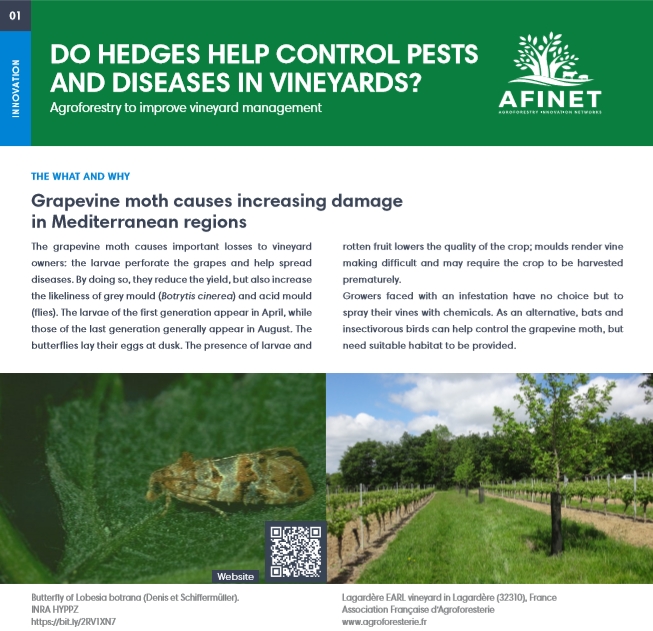 |
01 Do hedges help control pests and diseases in vineyards? The grapevine moth causes important losses to vineyard owners: the larvae perforate the grapes and help spread diseases. By doing so, they reduce the yield, but also increase the likeliness of grey mould ("Botrytis cinerea") and acid mould (flies). |
|
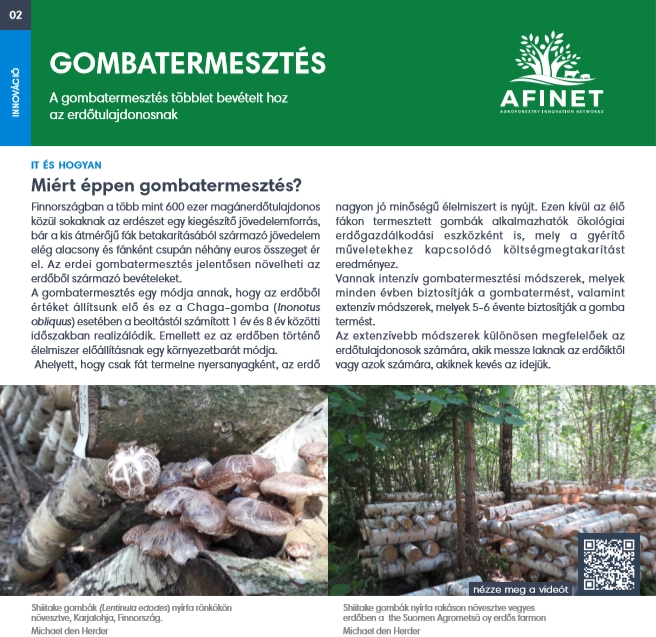 |
Finnországban a több mint 600 ezer magánerdőtulajdonos közül sokaknak az erdészet egy kiegészítő jövedelemforrás, bár a kis átmérőjű fák betakarításából származó jövedelem elég alacsony és fánként csupán néhány euros összeget ér el. Az erdei gombatermesztés jelentősen növelheti az erdőből származó bevételeket. |
|
 |
03 Dió (Juglans regia) agroerdészeti rendszerekben A diót (Juglans regia) Európa szerte termesztik. Ezeket a fákat magas piaci értéken tartják számon. A tápanyagban gazdag dió és a jó minőségű fája nagyra értékelt és ennek megfelelően a piaci kereslet is nagy iránta. A dél-európai és az EU mediterrán országok a vezetők az európai piacon, míg az USA és Kína a legfontosabb globális szereplők. A kereskedelmi célú diótermesztés még mindig ritka Flandriában és majdnem az összes diófélét importálják. |
|
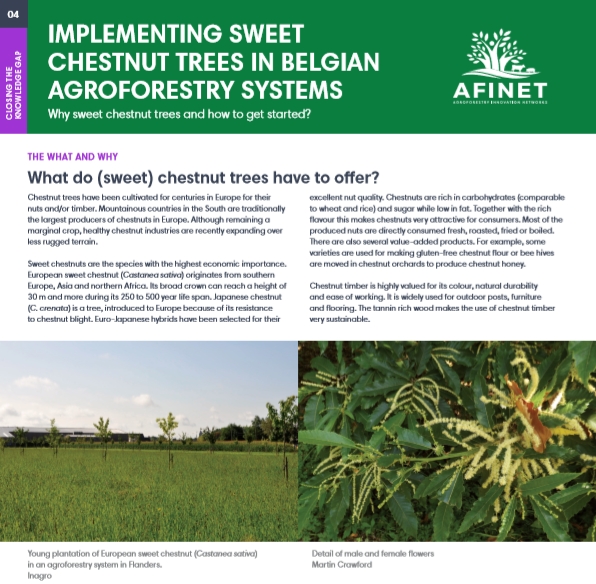 |
04 Implementing sweet chestnut trees in Belgian agroforestry systems Chestnut trees have been cultivated for centuries in Europe for their nuts and/or timber. Mountainous countries in the South are traditionally the largest producers of chestnuts in Europe. Although remaining a marginal crop, healthy chestnut industries are recently expanding over less rugged terrain. Download the high resolution print version (available soon) |
|
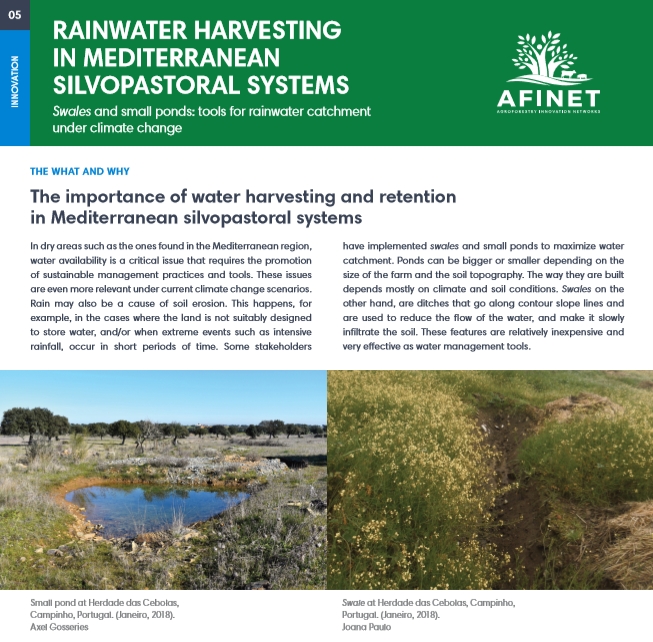 |
05 Rainwater harvesting in mediterranean silvopastoral systems In dry areas such as the ones found in the Mediterranean region, water availability is a critical issue that requires the promotion of sustainable management practices and tools. These issues are even more relevant under current climate change scenarios. Download the high resolution print version (available soon) |
|
 |
06 Mezővédő és széltörő erdősávok:: telepítésük alapelvei A szél hatással lehet a növényekre és az állatokra közvetlenül vagy közvetve a mikroklímával és a talajjal kapcsolatos mechanikai vagy fiziológiai folyamatokra. Számos olyan fás tájképi elem van, amelyek ha helyesen vannak megtervezve, akkor lehetővé teszik ezeknek a hatásoknak a csökkentését. Tájszinten a legtöbb esetben kombinálják ezeket az elemeket, szél általokozottkárokcsökkentésecéljából |
|
 |
07 Agroerdészet a körkörös gazdaságért A gazdasági növekedés általában a környezet rovására történik. A biogazdaság szükséges része annak a folyamatnak, amikor a fejlődésünket egy fenntarthatóbb gazdasági modellre cseréljük annak érdekében, hogy a legjelentősebb európai és globális kihívásokat úgy mint például a klímaváltozást, a biodiverzitás elvesztését, az erdőtüzeket vagy az óceánt ellepő műanyaghulladékok problémáját kezelni tudjuk. |
|
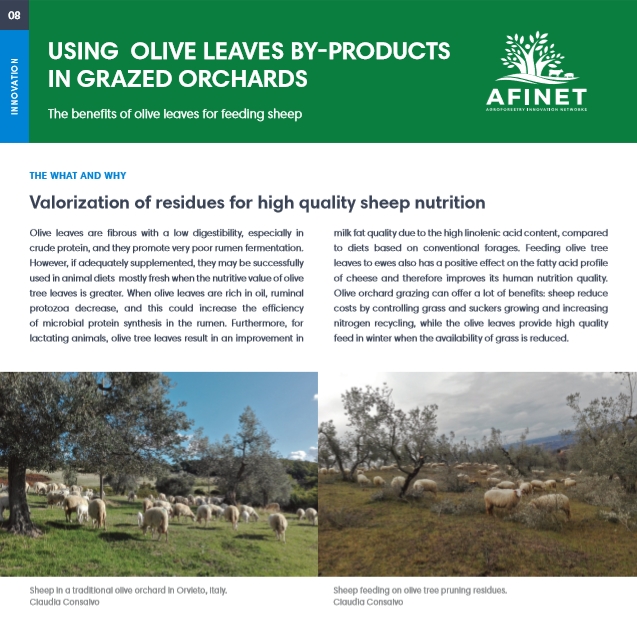 |
08 Using olive leaves by-products in grazed orchards Olive leaves are fibrous with a low digestibility, especially in crude protein, and they promote very poor rumen fermentation. However, if adequately supplemented, they may be successfully used in animal diets mostly fresh when the nutritive value of olive tree leaves is greater. |
|
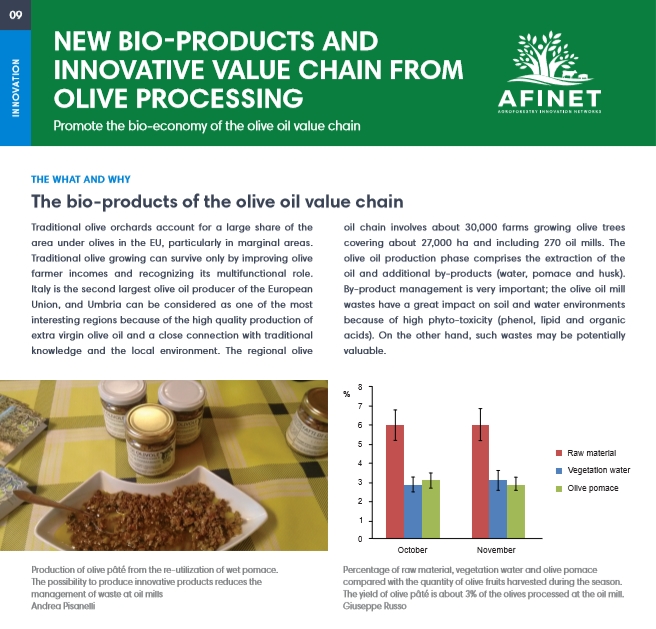 |
09 New bio-products and innovative value chain from olive processing Traditional olive orchards account for a large share of the area under olives in the EU, particularly in marginal areas. Traditional olive growing can survive only by improving olive farmer incomes and recognizing its multifunctional role. |
|
 |
10 A fasorok aljnövényzetének kezelése agroerdészeti rendszerekben A szántóföldi agroerdészeti rendszerekben mindig van egy bizonyosterület,amiafáklombkoronájaalatthelyezkedikel(pl. a fasorok alatt lévő sávok a közművelési rendszerekben), ahol bonyolult művelni a főnövényt. Mi ezt itt a fasor aljnövényzetének hívjuk. Ezeknek a területeknek számos fontos funkciója lehet: (i) a fák védelme a mezőgazdasági munkagépek okozta lehetséges károkkal szemben, (ii) hozzáférés biztosítása a fasorokhoz faápolás vagy gyümölcs szüretelés céljából, (iii) egy sor ökológiai szempont mint például a biodiverzitást biztosító élőhely és élelemforrás funkció. |
|
 |
11 Alley cropping diversifies your farm and improves the environment Alley cropping, or planting woody perennials rows in arable or vegetable fields, is an innovative idea worthy of exploration by farmers seeking both an additional long term income, rather than income based solely on annual production, and to increase the environmental resilience of their system. |
|
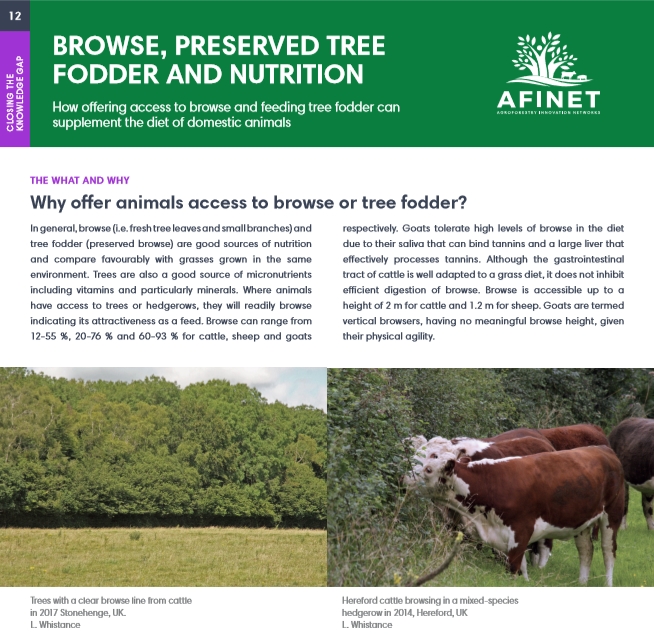 |
12 Browse, preserved tree fodder and nutrition In general, browse (i.e. fresh tree leaves and small branches) and tree fodder (preserved browse) are good sources of nutrition and compare favourably with grasses grown in the same environment. Trees are also a good source of micronutrients including vitamins and particularly minerals. |
|
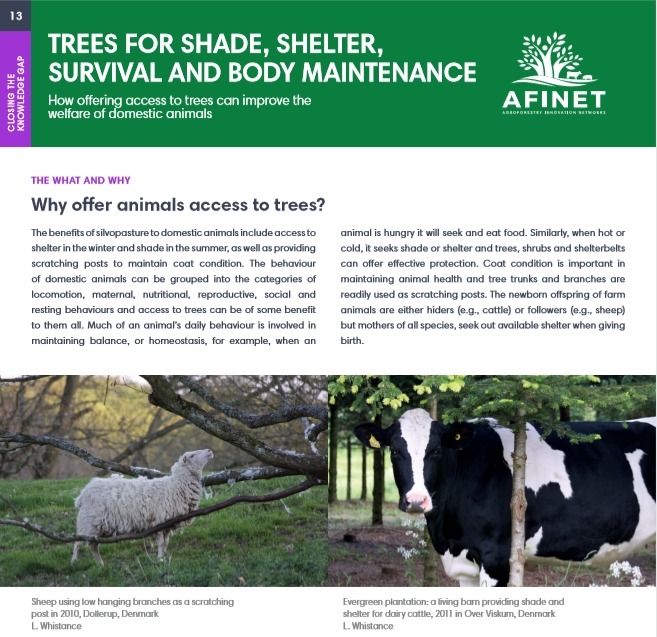 |
13 Trees for shade, shelter, survival and body maintenance The benefits of silvopasture to domestic animals include access to shelter in the winter and shade in the summer, as well as providing scratching posts to maintain coat condition. The behaviour of domestic animals can be grouped into the categories of locomotion, maternal, nutritional, reproductive, social and resting behaviours and access to trees can be of some benefit to them all. |
|
 |
14 A fasorok aljnövényzetszintjének produktív kihasználása Fák ültetése szántóföldbe vagy konyhakertbe azt jelenti, hogy a foldet kivonják az éves termelésből; a rendszer kialakításától függően, ez akár a terület 25% át is kiteheti. |
|
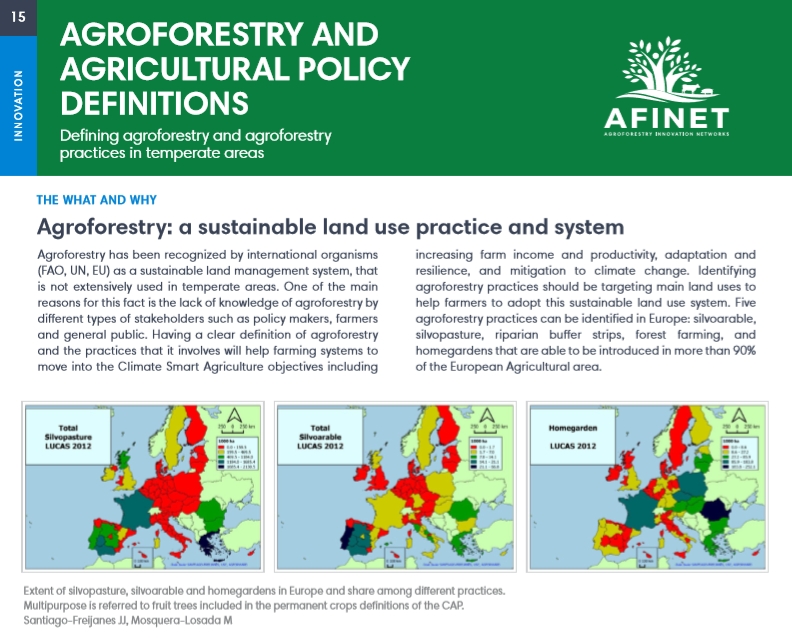 |
15 Agroforestry and agricultural policy definitions Agroforestry has been recognized by international organisms (FAO, UN, EU) as a sustainable land management system, that is not extensively used in temperate areas. One of the main reasons for this fact is the lack of knowledge of agroforestry by different types of stakeholders such as policy makers, farmers and general public. Download the high resolution print version (available soon) |
|
 |
Az európai pusztákhoz általában olyan földhasználati gyakorlatok kapcsolódnak, mint a kaszálás, égetés, legeltetés és az EU támogatja ezeket, mint magas természeti értékű területeket. Ugyanakkor a vidéki népességcsökkenés és a menedzsment gyakorlatok megváltozása hozzájárul a rendkívül gyúlékony fitomassza magas felhalmozódáshoz a pusztákon és az Atlanti-zónában lévő más cserjésekben, ezért ezek sokkal hajlamosabbak az erdőtűzre. |
|
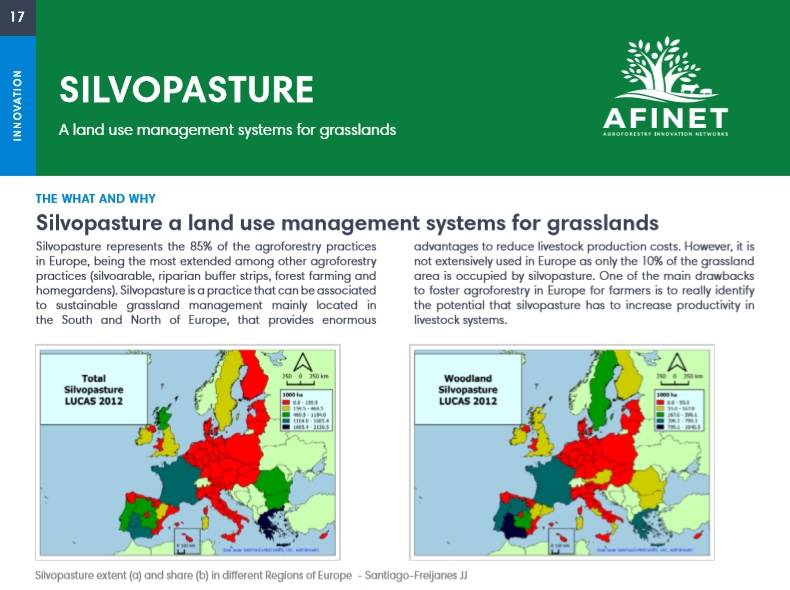 |
Silvopasture represents the 85% of the agroforestry practices in Europe, being the most extended among other agroforestry practices (silvoarable, riparian buffer strips, forest farming and homegardens). Silvopasture is a practice that can be associated to sustainable grassland management mainly located in the South and North of Europe, that provides enormous advantages to reduce livestock production costs. Download the high resolution print version (available soon) |
|
 |
18 Sövények hasznosítása tűzifa előállítására Ross Dickinson termelő, tüzelőanyag beszállító és kereskedő Dorsetben elmondja: “Megváltoztattam az egyik sövényem menedzsmentjét: az évenkénti metszés helyett hagyom nőni és csak minden 15. évben vágom le. Figyelembe véve a metszési költségek megtakarítását, jó nyereséget tudtam realizálni” |
|
 |
19 Agroerdészet sikerességét segítő együttműködés Az Egyesült Királyság gazdaságaiban a legtöbb meglévő agrárerdészeti rendszert olyan mezőgazdasági termelő hozta létre, aki egyben a földtulajdonos vagy a föld bérlője is. |
|
 |
20 Agroerdészet alkalmazása mezőgazdasági területeken A szántóföldeken alkalmazott hagyományos gazdálkodási rendszerek az ökoszisztéma-szolgáltatások csökkenéséhez, a talaj termőképességének romlásához, ezáltal pedig terméscsökkenéshez vezethetnek. A hagyományos gazdálkodási rendszerekben használt herbicidek és növényvédő szerek befolyásolják az élelmiszerek minőségét és egyre jelentősebb közegészségügyi problémákat okoznak. |
|
 |
21 A sövények és a magányos fák szerepe európában Az agroerdészet egy fenntartható földhasználati rendszer, amelyet közvetlenül támogat a zöldítés és a KAP II. Pillére (8.2. Intézkedés). Közvetetten szerepel a KAP más részeiben is, mint pl. a kölcsönös megfeleltetés vagy a feltételesség, amely a környezet megóvását célozza. |
|
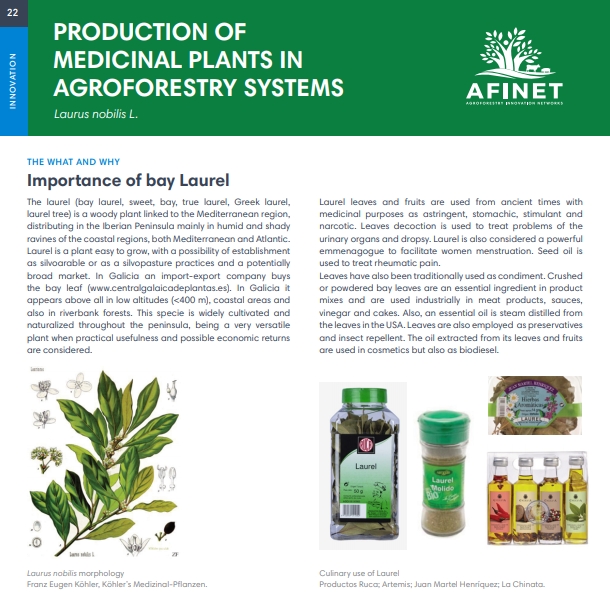 |
22 Production of medicinal plants in agroforestry systems The laurel (bay laurel, sweet, bay, true laurel, Greek laurel, laurel tree) is a woody plant linked to the Mediterranean region, distributing in the Iberian Peninsula mainly in humid and shady ravines of the coastal regions, both Mediterranean and Atlantic. Laurel is a plant easy to grow, with a possibility of establishment as silvoarable or as a silvopasture practices and a potentially broad market Download the high resolution print version (available soon) |
|
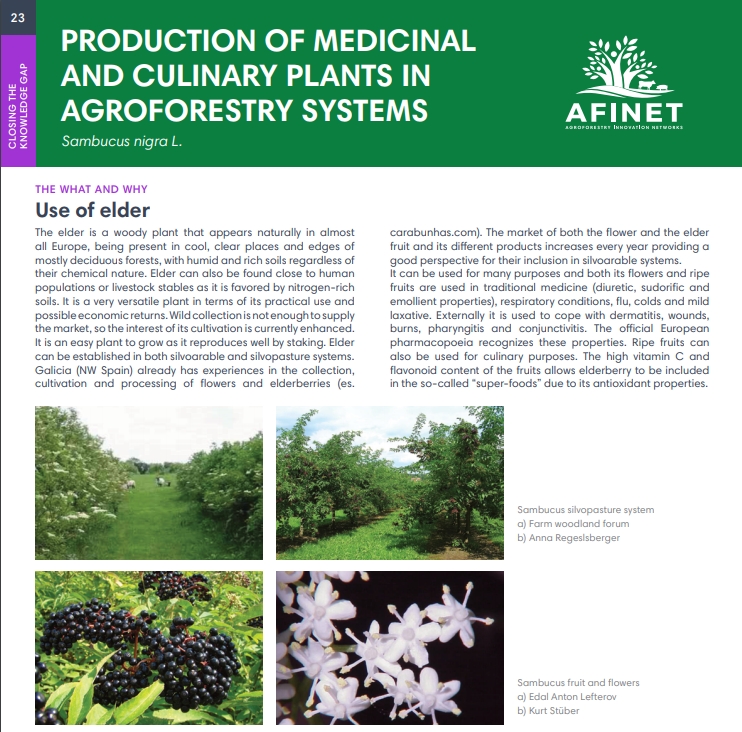 |
23 Production of medicinal and culinary plants in agroforestry systems The elder is a woody plant that appears naturally in almost all Europe, being present in cool, clear places and edges of mostly deciduous forests, with humid and rich soils regardless of their chemical nature. Elder can also be found close to human populations or livestock stables as it is favored by nitrogen-rich soils. Download the high resolution print version (available soon) |
|
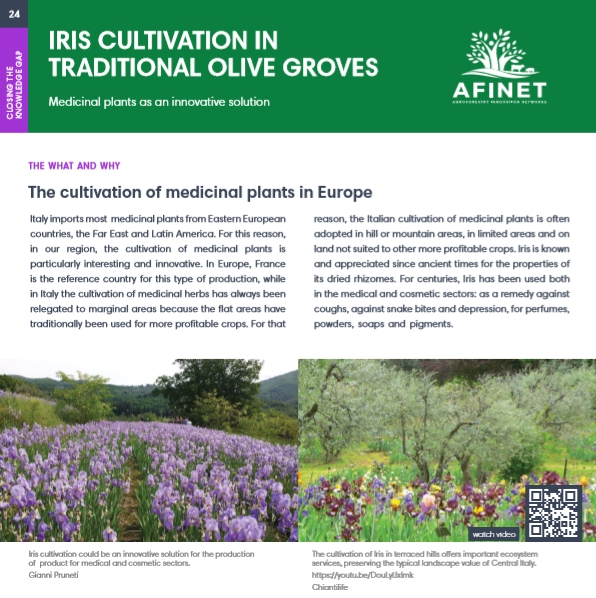 |
24 Iris cultivation in traditional olive groves Italy imports most medicinal plants from Eastern European countries, the Far East and Latin America. For this reason, in our region, the cultivation of medicinal plants is particularly interesting and innovative. In Europe, France is the reference country for this type of production, while in Italy the cultivation of medicinal herbs has always been relegated to marginal areas because the flat areas have traditionally been used for more profitable crops. |
|
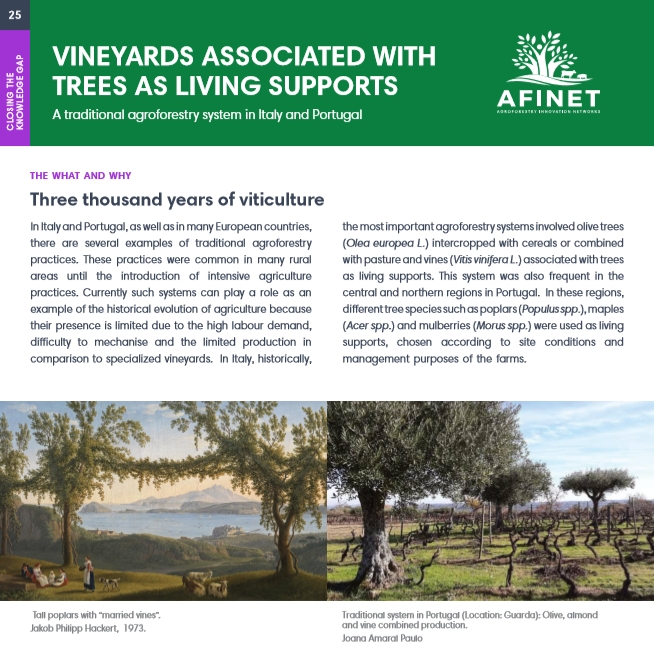 |
25 Vineyards associated with trees as living supports In Italy and Portugal, as well as in many European countries, there are several examples of traditional agroforestry practices. These practices were common in many rural areas until the introduction of intensive agriculture practices. Currently such systems can play a role as an example of the historical evolution of agriculture because their presence is limited due to the high labour demand, difficulty to mechanise and the limited production in comparison to specialized vineyards. |
|
 |
Az EU mezőgazdasági földterületein jellemzően intenzív gazdálkodás folyik, amely korlátozza az ökoszisztémaszolgáltatásokat (ÖSZ). Az agroerdészetet (AE), mint fenntartható gazdálkodást, amely piaci és nem piaci termékeket és szolgáltatásokat nyújt és ezzel támogatja a társadalmi célok elérését, erőteljesen kell támogatni a KAP-ban. |
|
 |
27 Agroerdészet, kap és fenntartható fejlesztési célok Az EU-ban a mezőgazdaság 44 millió munkahelyet teremt az élelmiszerláncban és földterületének 48%-án 500 millió fogyasztó számára biztosít biztonságos élelmiszert. A közös agrárpolitika (KAP) az európai mezőgazdaság fő politikai mozgatórugója, célja nemcsak az európai polgárok élelmezésének biztosítása (Cork 2.0 nyilatkozat), hanem a globális stratégiai politikák, például a fenntartható fejlesztési célok (SDG) betartása is (ENSZ, 2015). |
|
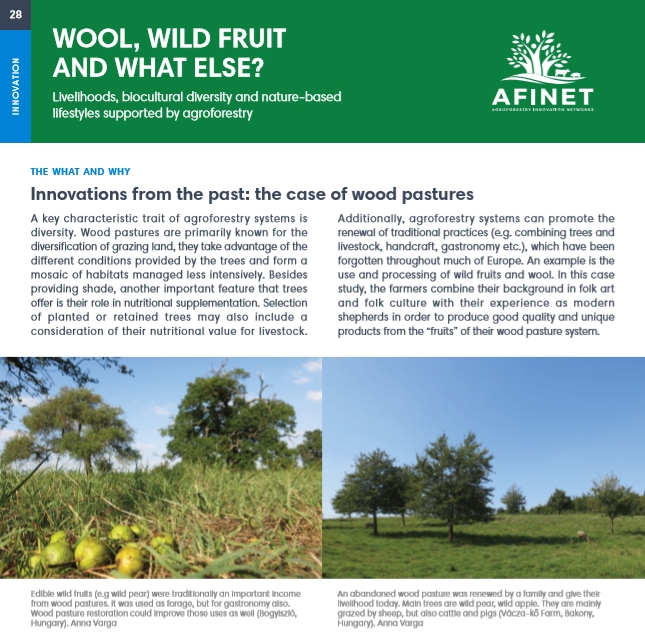 |
28 Gyapjú, gyümölcsök és még mi más? Az agrárerdészeti rendszerek egyik legfontosabb jellemzője a sokféleség. A fáslegelők elsősorban a változatosságukról ismertek, kihasználják a fák által nyújtott előnyöket és kevésbé intenzíven kezelt élőhelyek mozaikját képezik. |
|
 |
29 Húsmarha tenyésztés agroerdészeti rendszerekben A legelőn tartott állatállomány fenntartásának egyik nehézsége az, hogy megfelelő megoldást találjunk az állatok egész évben történő takarmányozására. A tenyészidőszak végére a fű tápanyag-értéke alacsony a nyári aszály miatt. |
|
 |
Az erdőkertek (amelyeket néha házi kerteknek hívnak) elsősorban vagy teljes egészében évelő polikultúrák, amelyekben az élelmiszer-növények - beleértve a fákat, cserjéket és az évelő lágyszárú növényeket - legalább három azonosítható vegetációs szintet alkotnak. Számos méret, forma és élőhely jellemzi őket, a vidékitől a városiig, a fásítástól a sűrű erdőig (Jacke és Toensmeier 2011). |
|
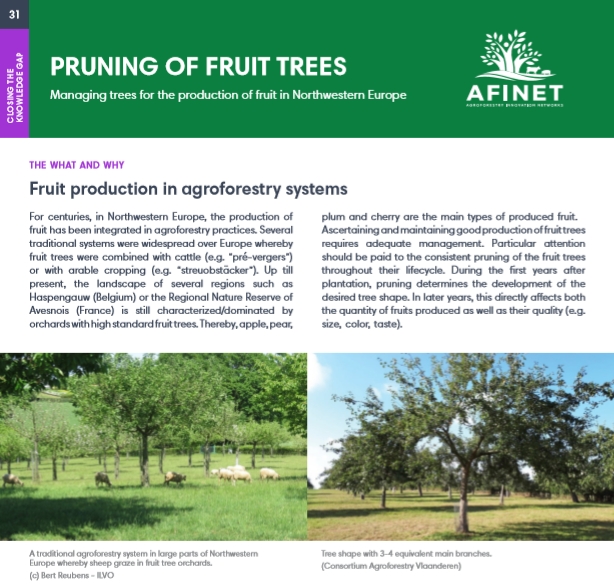 |
For centuries, in Northwestern Europe, the production of fruithasbeenintegratedinagroforestrypractices.Several traditional systems were widespread over Europe whereby fruit trees were combined with cattle (e.g. “pré-vergers”) or with arable cropping (e.g. “streuobstäcker”). Download the high resolution print version (available soon) |
|
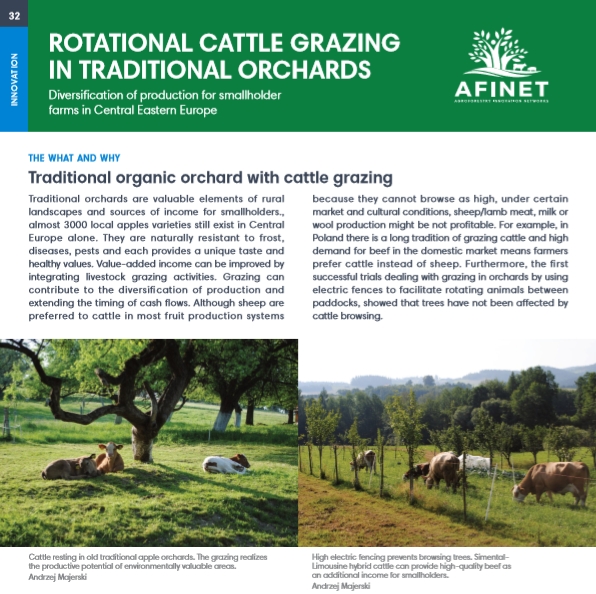 |
32 Rotational cattle grazing in traditional orchards Traditional orchards are valuable elements of rural landscapes and sources of income for smallholders., almost 3000 local apples varieties still exist in Central Europe alone. They are naturally resistant to frost, diseases, pests and each provides a unique taste and healthy values. Value-added income can be improved by integrating livestock grazing activities. Download the high resolution print version (available soon) |
|
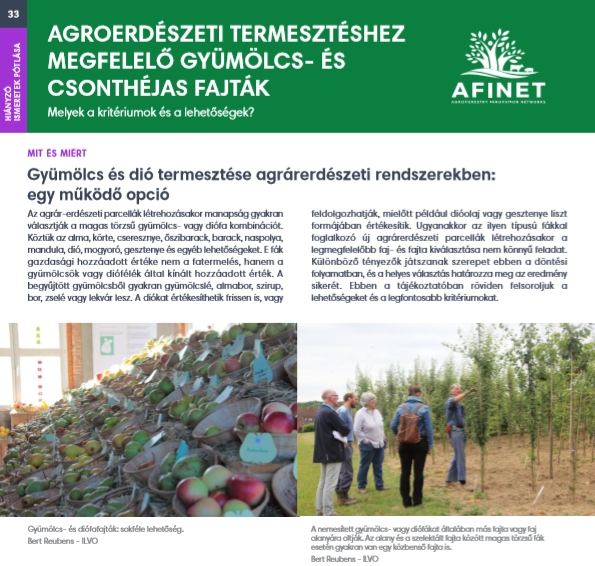 |
33 Agroerdészeti termesztéshez megfelelő gyümölcs- és csonthéjas fajták Az agrár-erdészeti parcellák létrehozásakor manapság gyakran választják a magas törzsű gyümölcs- vagy diófa kombinációt. Köztük az alma, körte, cseresznye, őszibarack, barack, naspolya, mandula,dió, mogyoró, gesztenye és egyéb lehetőségeket. |
|
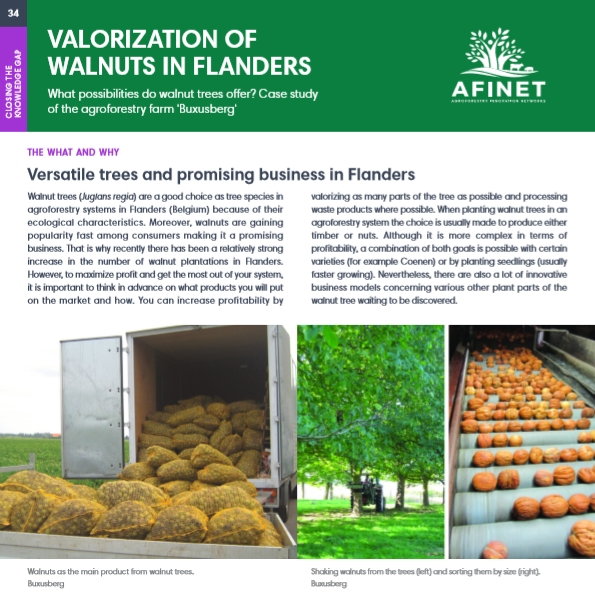 |
34 Valorization of walnuts in Flanders Walnut trees (Juglans regia) are a good choice as tree species in agroforestry systems in Flanders (Belgium) because of their ecological characteristics. Moreover, walnuts are gaining popularity fast among consumers making it a promising business. That is why recently there has been a relatively strong increase in the number of walnut plantations in Flanders. Download the high resolution print version (available soon) |
|
 |
35 Gyorsannövő fafajok használata vetésforgóban Közepes vagy gyenge kukorica-termőterületen a rövid vágásfordulójú faültetvényeket be lehet építeni vetésforgóba a talajviszonyok javítása és a rendszer termelésének fokozása érdekében. Az ilyen agrárerdészeti rendszerek egyik lehetősége a fák biomassza-célú ültetése nagy sűrűséggel. |
|
 |
36 Sövények és széltörő védősávok többcélú alkalmazása Kihívást jelenthet egy olyan kisebb, önellátó családi ökogazdaság működtetése, amely intenzíven kezelt mezőgazdasági területekkel van körülvéve. Amint ez az esettanulmányból kitűnik, ez egy munkaigényes projekt, de megfelelő tervezéssel és irányítással sikeres lehet. Az itt bemutatott családi gazdaság 12 hektáros földterületen jött létre Magyarországon. |
|
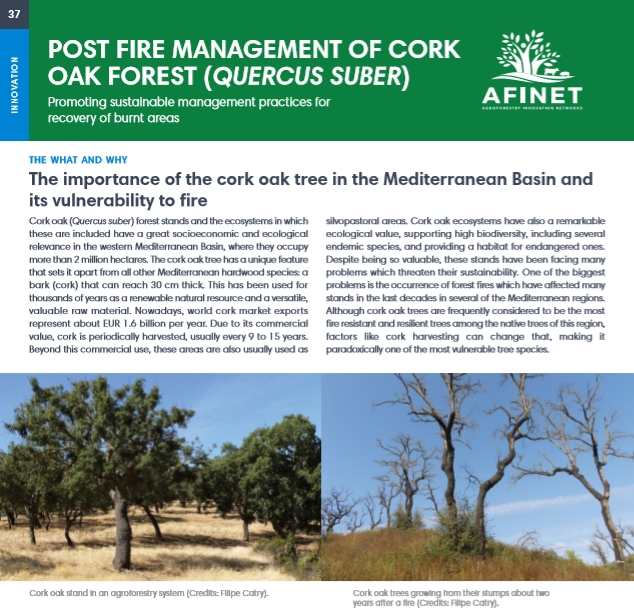 |
37 Post fire management of cork oak forest (Quercus suber) It can be a challenge to build up a self-sustaining organic family farm operated on some ten hectares in an intensively managed agricultural area. As this case study implies, it is a work-intensive project but can be successful with proper planning and management. The family farm introduced in this case study is established on 12-hectares of land in Hungary. Download the high resolution print version (available soon) |
|
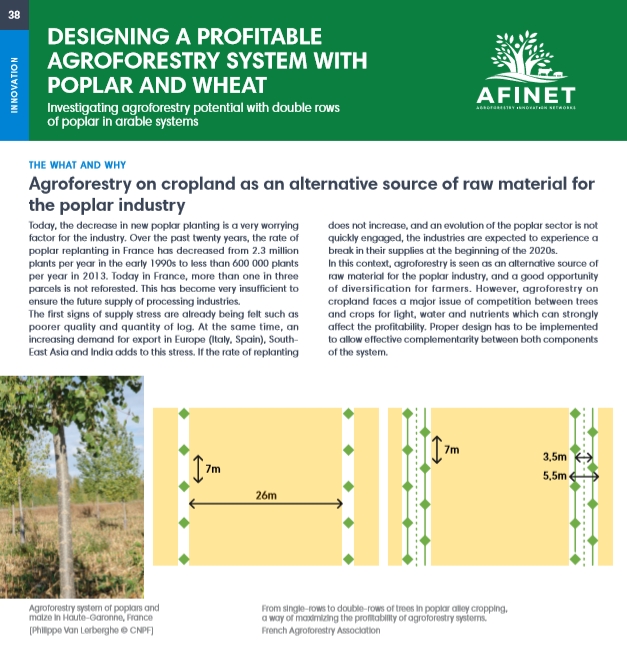 |
38 Designing a profitable agroforestry system with poplar and wheat Today, the decrease in new poplar planting is a very worrying factor for the industry. Over the past twenty years, the rate of poplar replanting in France has decreased from 2.3 million plants per year in the early 1990s to less than 600 000 plants per year in 2013. Today in France, more than one in three parcels is not reforested. This has become very insufficient to ensure the future supply of processing industries. |
|
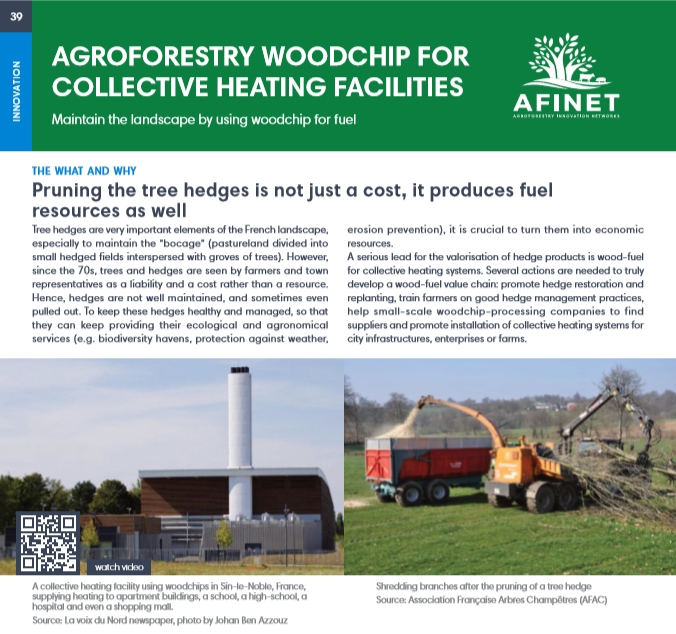 |
39 Agroforestry woodchip for collective heating facilities Tree hedges are very important elements of the French landscape, especially to maintain the “bocage” (pastureland divided into small hedged fields interspersed with groves of trees). However, since the 70s, trees and hedges are seen by farmers and town representatives as a liability and a cost rather than a resource. |
|
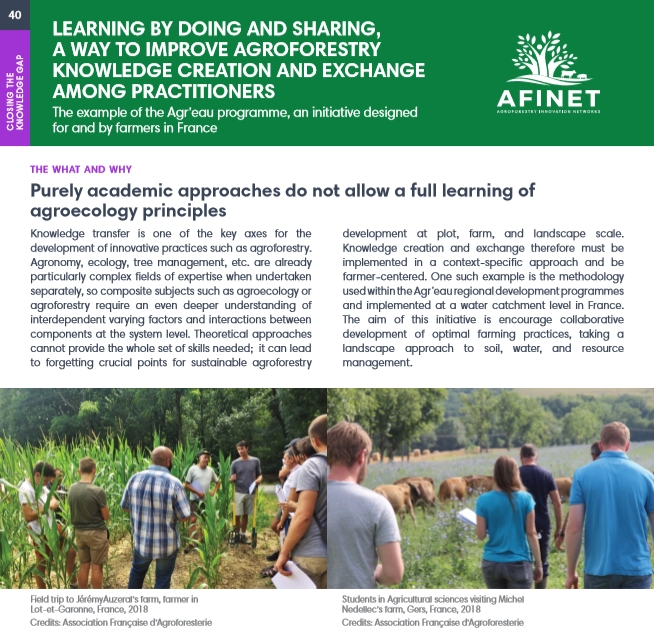 |
Knowledge transfer is one of the key axes for the development of innovative practices such as agroforestry. Agronomy, ecology, tree management, etc. are already particularly complex fields of expertise when undertaken separately, so composite subjects such as agroecology or agroforestry require an even deeper understanding of interdependent varying factors and interactions between components at the system level. |
|
 |
41 Fák a termőföldön” mint értékesítési érv Az agrárerdészetet, amely jelenleg Franciaországban továbbra is marginális gazdálkodási forma, a fogyasztók még nem ismerik jól. Tudjuk azonban, hogy az élelem előállításának ez a módja, agroökológiai megközelítéssel kombinálva, fenntarthatóbb rendszerekhez vezet. |
|
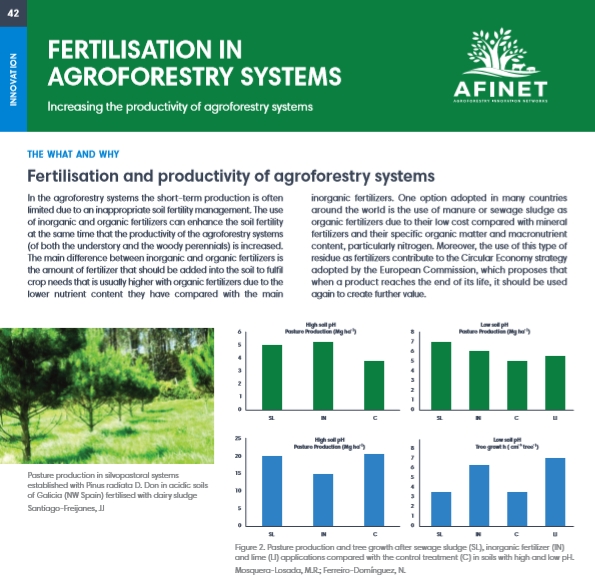 |
42 Fertilisation in agroforestry systems In the agroforestry systems the short-term production is often limited due to an inappropriate soil fertility management. The use of inorganic and organic fertilizers can enhance the soil fertility at the same time that the productivity of the agroforestry systems (of both the understory and the woody perennials) is increased. Download the high resolution print version (available soon) |
|
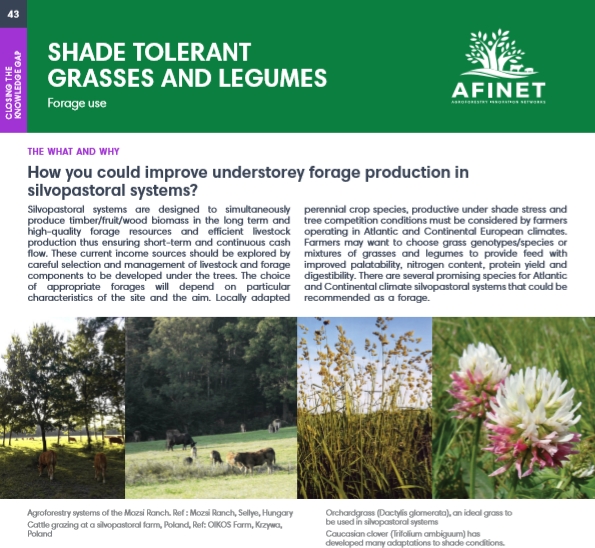 |
43 Shade tolerant grasses and legumes Silvopastoral systems are designed to simultaneously produce timber/fruit/wood biomass in the long term and high-quality forage resources and efficient livestock production thus ensuring short-term and continuous cash flow. Download the high resolution print version (available soon) |
|
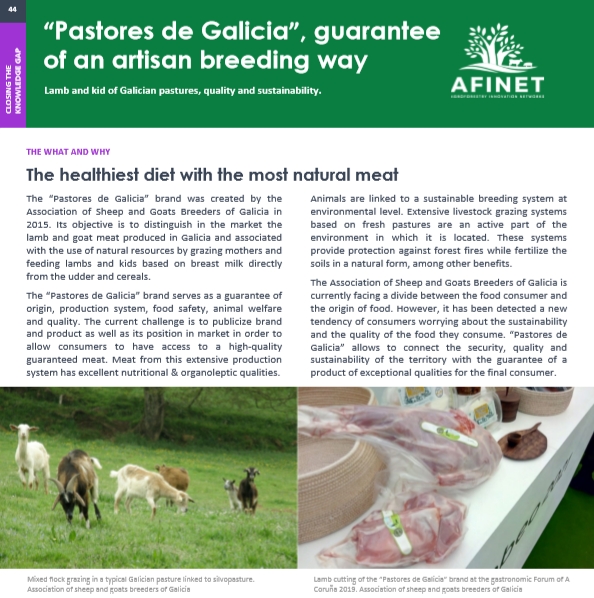 |
44 “Pastores de Galicia”, guarantee of an artisan breeding way The “Pastores de Galicia” brand was created by the Association of Sheep and Goats Breeders of Galicia in 2015. Its objective is to distinguish in the market the lamb and goat meat produced in Galicia and associated with the use of natural resources by grazing mothers and feeding lambs and kids based on breast milk directly from the udder and cereals. Download the high resolution print version (available soon) |
|
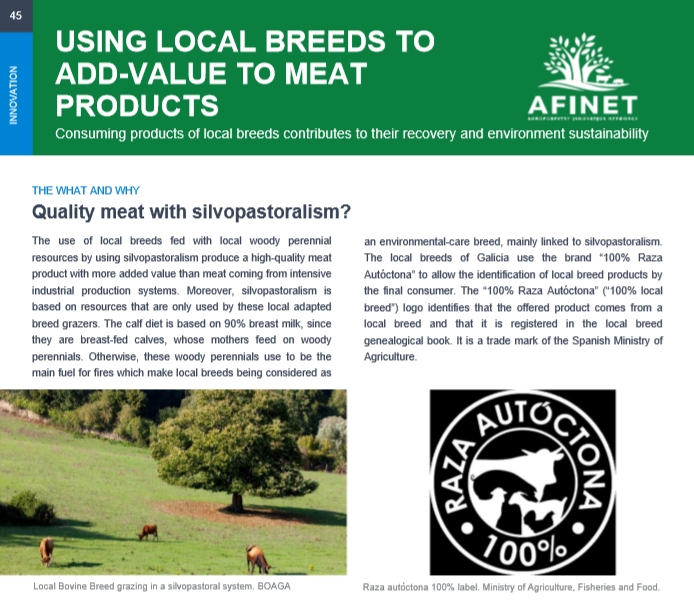 |
45 Using local breeds to add-value to meat products The use of local breeds fed with local woody perennial resources by using silvopastoralism produce a high-quality meat product with more added value than meat coming from intensive industrial production systems. Moreover, silvopastoralism is based on resources that are only used by these local adapted breed grazers. The calf diet is based on 90% breast milk, since they are breast-fed calves, whose mothers feed on woody perennials.
Download the high resolution print version (available soon) |











